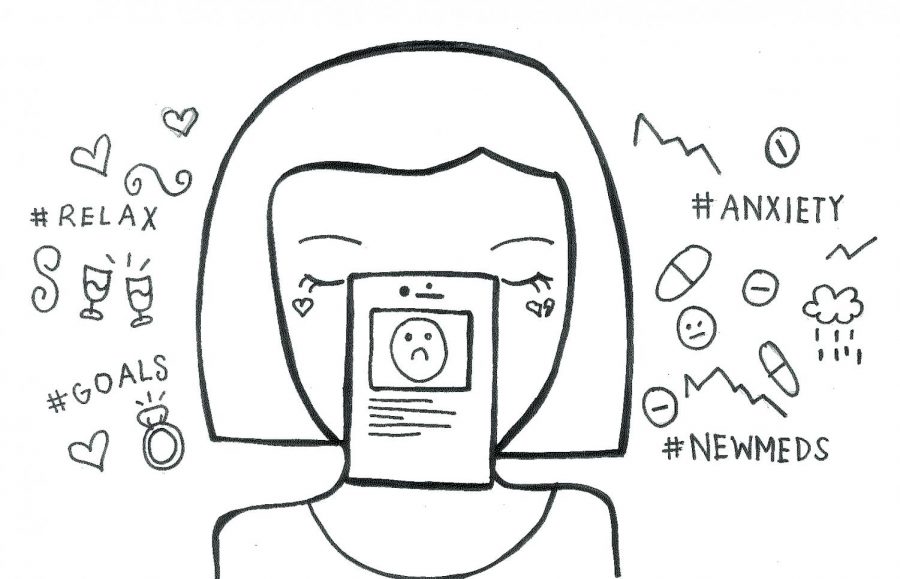With anxiety on the rise, resources are available for those who suffer
Anxiety is like sitting at the top of a roller coaster . . . barreling towards the ground, all control lost, without the power to prevent the crash.
On a daily basis, one third of teenagers suffer from severe anxiety, according to the National Institute of Mental Health.
It impacts 18.1% of the US population, and yet only 36.9% seek treatmeant.
One Eastern student described anxiety as if the heart was “beating out of my chest.” There is a sick and a sweaty feeling. “I get a lot of headaches,” the student said. “It can feel like a stomach bug.”
Anxiety can incapacitate students. Anxiety’s prominence continues to increase. Authorities cite parental pressures, terrorism, media fears, and social media pressures. Critics also cite the overwhelming presence of today’s technology.
School psychologist Dr. Pissalidis said symptoms include hyperventilation, headaches, and panic attacks. “It’s when your mind is constantly going and the worries just keep coming,” she said.
Mr. Anderson, guidance counselor, said in speaking to different students, it used to be students only compared each other to peers in school, what they were wearing and who they were talking to.
“Now you can’t escape it,” he said. “You go home you check Snapchat, you check your Twitter feed, it’s caused a lot of feelings of rejection.”
In the past, if someone was left out, he said, you were unaware.
“But now you have to watch it as it’s happening,” he said.
Research demonstrates how students internalize anxiety until they are overpowered by rejection and overcome by worry. A member of the Child Studies Team, Mrs. Krul, described how a certain level of anxiety is typical. However, when the anxiety becomes debilitating – preventing someone from leaving the house, from attending school, or even from spending time with friends, it becomes an urgent problem.
Junior Manal Desai said anxiety has increased in students, not only because of school, but from worrying about being accepted. “Anxiety can be caused by ideas like, ‘How many friends should I have’ or ‘no one will like me if I don’t do what everybody else is doing,” she said.
If this trend continues, students will be unable to function in reality, for as they constantly feel the urge to stress about their online image.
Similarly, junior Haley Allsebrook feels overwhelmed by the combined pressure instilled by the competitiveness among her peers and from her parents’ expectations to succeed in school, with the goal of filling up her college resume.
Mr. Anderson agreed. He described the common practice of this intense pressure on students, explaining how a majority of students are becoming overloaded with activities and classes.
One student wondered why he always felt anxious. “Sometimes I don’t know,” he said. “It just comes and goes. Sometimes you know. Sometimes you don’t.”
Social media, the critics and professionals have said, has allowed anxiety to run rampant. Teenagers are no longer learning how to cope with their anxiety, only how to hide from it by the use of cell phones.
“Teens will go places if they feel like they know everything that will happen, if they know everyone who will be there, if they can see who’s checked in online,” the clinical director of the NW Anxiety Institute, Kevin Ashworth, told The New York Times Magazine.
“But life doesn’t always come with that kind of certainty, and they’re never practicing the skill of rolling with the punches, of walking into an unknown or awkward social situation and learning that they can survive it.”
Allsebrook described that she finds myself at some point every day using her phone as an escape when she feels anxious. “I plug in my earbuds after almost every class to close out all the noise,” she said. “Music calms me down so much, so in order to get through the whole day, I have to spare some time even if it’s only for two minutes to close out everything and jam to some 80’s music.”
Anxiety seems inevitable for many students, but if repressed, it can eventually become chronic. However, Eastern offers resources to students suffering from anxiety.
Mr. Anderson is the head of an anxiety support group for Eastern students. Staff members and faculty refer students to him to get the help they need. If students would like to join Mr. Anderson’s support group, they can speak with their counselor or directly to Mr. Anderson. Meeting times are confidential, and anyone is welcome to join.
Some students are able to attend Eastern’s satellite campus, the Eastern Learning Academy (ELA), to experience a calmer school atmosphere when dealing with severe anxiety. An ELA student said the change in setting helped take the edge off of her anxiety. School is inevitably stressful, she said, but with less homework and having to stay in only a few classrooms during the day, it is a better learning environment.
Furthermore, the guidance counselors always have an open door for any student having a stressful day. Students with incapacitating anxiety are able to receive special education services, resulting in the option to meet with Dr. Pissalidis or school social workers, who can all be found in the Special Services Office which neighbors the Main Office.
To decrease anxiety, Dr. Pissalidis believes in supported exposure to whatever it is that is making them anxious. If school is the thing that is making them anxious, then you can’t avoid it. You need to get your foot in the door, that’s step one. After that, you need to stay there for five minutes, ten minutes, one class, two classes. Systematic desensitization. You are exposed to it in manageable chunks.”
Mrs. Krul also works with students, teaching them to utilize deep breathing, guiding imagery, meditation, and journaling to further manage their daily stress.
Although enrolling in classes online is available, Mrs. Krul said, “If you think long term, you can’t do life online. You want to go to college, you want to work.”
Dr. Pissalidis concured.
“Like any other technique,” she said, “it is good to get your foot in the door, but it is not a replacement for being fully there in person. The ultimate goal is to get you into school.”







